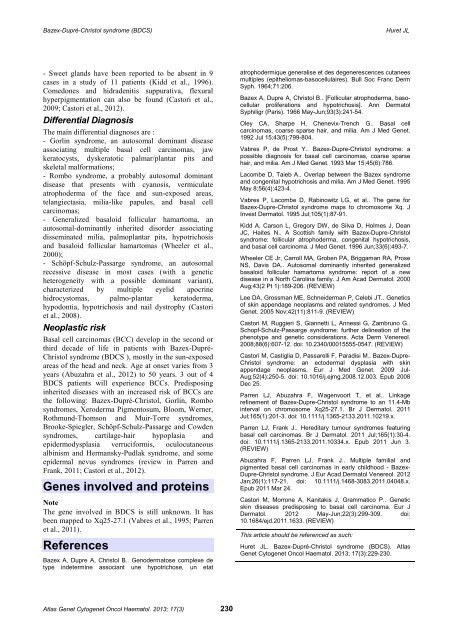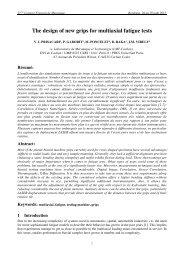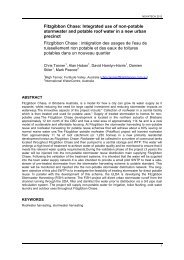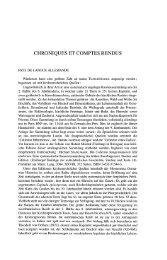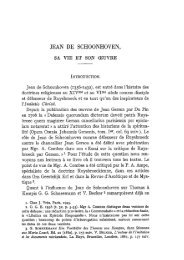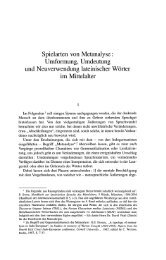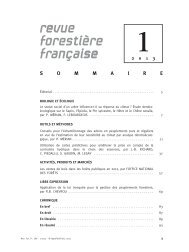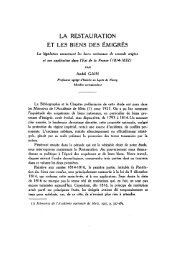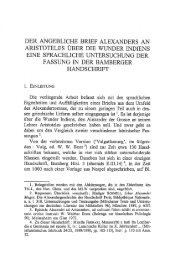Bazex-Dupré-Christol syndrome - Inist
Bazex-Dupré-Christol syndrome - Inist
Bazex-Dupré-Christol syndrome - Inist
You also want an ePaper? Increase the reach of your titles
YUMPU automatically turns print PDFs into web optimized ePapers that Google loves.
<strong>Bazex</strong>-<strong>Dupré</strong>-<strong>Christol</strong> <strong>syndrome</strong> (BDCS) Huret JL<br />
- Sweet glands have been reported to be absent in 9<br />
cases in a study of 11 patients (Kidd et al., 1996).<br />
Comedones and hidradenitis suppurativa, flexural<br />
hyperpigmentation can also be found (Castori et al.,<br />
2009; Castori et al., 2012).<br />
Differential Diagnosis<br />
The main differential diagnoses are :<br />
- Gorlin <strong>syndrome</strong>, an autosomal dominant disease<br />
associating multiple basal cell carcinomas, jaw<br />
keratocysts, dyskeratotic palmar/plantar pits and<br />
skeletal malformations;<br />
- Rombo <strong>syndrome</strong>, a probably autosomal dominant<br />
disease that presents with cyanosis, vermiculate<br />
atrophoderma of the face and sun-exposed areas,<br />
telangiectasia, milia-like papules, and basal cell<br />
carcinomas;<br />
- Generalized basaloid follicular hamartoma, an<br />
autosomal-dominantly inherited disorder associating<br />
disseminated milia, palmoplantar pits, hypotrichosis<br />
and basaloid follicular hamartomas (Wheeler et al.,<br />
2000);<br />
- Schöpf-Schulz-Passarge <strong>syndrome</strong>, an autosomal<br />
recessive disease in most cases (with a genetic<br />
heterogeneity with a possible dominant variant),<br />
characterized by multiple eyelid apocrine<br />
hidrocystomas, palmo-plantar keratoderma,<br />
hypodontia, hypotrichosis and nail dystrophy (Castori<br />
et al., 2008).<br />
Neoplastic risk<br />
Basal cell carcinomas (BCC) develop in the second or<br />
third decade of life in patients with <strong>Bazex</strong>-<strong>Dupré</strong>-<br />
<strong>Christol</strong> <strong>syndrome</strong> (BDCS ), mostly in the sun-exposed<br />
areas of the head and neck. Age at onset varies from 3<br />
years (Abuzahra et al., 2012) to 50 years. 3 out of 4<br />
BDCS patients will experience BCCs. Predisposing<br />
inherited diseases with an increased risk of BCCs are<br />
the following: <strong>Bazex</strong>-<strong>Dupré</strong>-<strong>Christol</strong>, Gorlin, Rombo<br />
<strong>syndrome</strong>s, Xeroderma Pigmentosum, Bloom, Werner,<br />
Rothmund-Thomson and Muir-Torre <strong>syndrome</strong>s,<br />
Brooke-Spiegler, Schöpf-Schulz-Passarge and Cowden<br />
<strong>syndrome</strong>s, cartilage-hair hypoplasia and<br />
epidermodysplasia verruciformis, oculocutaneous<br />
albinism and Hermansky-Pudlak <strong>syndrome</strong>, and some<br />
epidermal nevus <strong>syndrome</strong>s (review in Parren and<br />
Frank, 2011; Castori et al., 2012).<br />
Genes involved and proteins<br />
Note<br />
The gene involved in BDCS is still unknown. It has<br />
been mapped to Xq25-27.1 (Vabres et al., 1995; Parren<br />
et al., 2011).<br />
References<br />
<strong>Bazex</strong> A, Dupre A, <strong>Christol</strong> B.. Genodermatose complexe de<br />
type indetermine associant une hypotrichose, un etat<br />
Atlas Genet Cytogenet Oncol Haematol. 2013; 17(3) 230<br />
atrophodermique generalise et des degenerescences cutanees<br />
multiples (epitheliomas-basocellulaires). Bull Soc Franc Derm<br />
Syph. 1964;71:206.<br />
<strong>Bazex</strong> A, Dupre A, <strong>Christol</strong> B.. [Follicular atrophoderma, basocellular<br />
proliferations and hypotrichosis]. Ann Dermatol<br />
Syphiligr (Paris). 1966 May-Jun;93(3):241-54.<br />
Oley CA, Sharpe H, Chenevix-Trench G.. Basal cell<br />
carcinomas, coarse sparse hair, and milia. Am J Med Genet.<br />
1992 Jul 15;43(5):799-804.<br />
Vabres P, de Prost Y.. <strong>Bazex</strong>-Dupre-<strong>Christol</strong> <strong>syndrome</strong>: a<br />
possible diagnosis for basal cell carcinomas, coarse sparse<br />
hair, and milia. Am J Med Genet. 1993 Mar 15;45(6):786.<br />
Lacombe D, Taieb A.. Overlap between the <strong>Bazex</strong> <strong>syndrome</strong><br />
and congenital hypotrichosis and milia. Am J Med Genet. 1995<br />
May 8;56(4):423-4.<br />
Vabres P, Lacombe D, Rabinowitz LG, et al.. The gene for<br />
<strong>Bazex</strong>-Dupre-<strong>Christol</strong> <strong>syndrome</strong> maps to chromosome Xq. J<br />
Invest Dermatol. 1995 Jul;105(1):87-91.<br />
Kidd A, Carson L, Gregory DW, de Silva D, Holmes J, Dean<br />
JC, Haites N.. A Scottish family with <strong>Bazex</strong>-Dupre-<strong>Christol</strong><br />
<strong>syndrome</strong>: follicular atrophoderma, congenital hypotrichosis,<br />
and basal cell carcinoma. J Med Genet. 1996 Jun;33(6):493-7.<br />
Wheeler CE Jr, Carroll MA, Groben PA, Briggaman RA, Prose<br />
NS, Davis DA.. Autosomal dominantly inherited generalized<br />
basaloid follicular hamartoma <strong>syndrome</strong>: report of a new<br />
disease in a North Carolina family. J Am Acad Dermatol. 2000<br />
Aug;43(2 Pt 1):189-206. (REVIEW)<br />
Lee DA, Grossman ME, Schneiderman P, Celebi JT.. Genetics<br />
of skin appendage neoplasms and related <strong>syndrome</strong>s. J Med<br />
Genet. 2005 Nov;42(11):811-9. (REVIEW)<br />
Castori M, Ruggieri S, Giannetti L, Annessi G, Zambruno G..<br />
Schopf-Schulz-Passarge <strong>syndrome</strong>: further delineation of the<br />
phenotype and genetic considerations. Acta Derm Venereol.<br />
2008;88(6):607-12. doi: 10.2340/00015555-0547. (REVIEW)<br />
Castori M, Castiglia D, Passarelli F, Paradisi M.. <strong>Bazex</strong>-Dupre-<br />
<strong>Christol</strong> <strong>syndrome</strong>: an ectodermal dysplasia with skin<br />
appendage neoplasms. Eur J Med Genet. 2009 Jul-<br />
Aug;52(4):250-5. doi: 10.1016/j.ejmg.2008.12.003. Epub 2008<br />
Dec 25.<br />
Parren LJ, Abuzahra F, Wagenvoort T, et al.. Linkage<br />
refinement of <strong>Bazex</strong>-Dupre-<strong>Christol</strong> <strong>syndrome</strong> to an 11.4-Mb<br />
interval on chromosome Xq25-27.1. Br J Dermatol. 2011<br />
Jul;165(1):201-3. doi: 10.1111/j.1365-2133.2011.10219.x.<br />
Parren LJ, Frank J.. Hereditary tumour <strong>syndrome</strong>s featuring<br />
basal cell carcinomas. Br J Dermatol. 2011 Jul;165(1):30-4.<br />
doi: 10.1111/j.1365-2133.2011.10334.x. Epub 2011 Jun 3.<br />
(REVIEW)<br />
Abuzahra F, Parren LJ, Frank J.. Multiple familial and<br />
pigmented basal cell carcinomas in early childhood - <strong>Bazex</strong>-<br />
Dupre-<strong>Christol</strong> <strong>syndrome</strong>. J Eur Acad Dermatol Venereol. 2012<br />
Jan;26(1):117-21. doi: 10.1111/j.1468-3083.2011.04048.x.<br />
Epub 2011 Mar 24.<br />
Castori M, Morrone A, Kanitakis J, Grammatico P.. Genetic<br />
skin diseases predisposing to basal cell carcinoma. Eur J<br />
Dermatol. 2012 May-Jun;22(3):299-309. doi:<br />
10.1684/ejd.2011.1633. (REVIEW)<br />
This article should be referenced as such:<br />
Huret JL. <strong>Bazex</strong>-<strong>Dupré</strong>-<strong>Christol</strong> <strong>syndrome</strong> (BDCS). Atlas<br />
Genet Cytogenet Oncol Haematol. 2013; 17(3):229-230.


